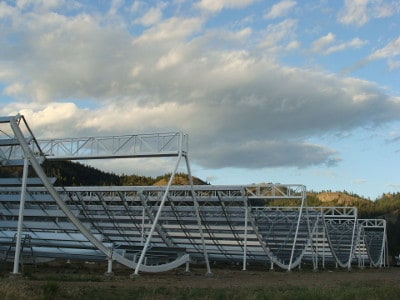
 Calgary-based CoolIT Systems, Inc. has been selected by the University of Toronto to provide custom liquid cooling for the signal processing backend of the $11 million Canadian Hydrogen Intensity Mapping Experiment (CHIME) project.
Calgary-based CoolIT Systems, Inc. has been selected by the University of Toronto to provide custom liquid cooling for the signal processing backend of the $11 million Canadian Hydrogen Intensity Mapping Experiment (CHIME) project.
CHIME, located in Penticton, B.C., is the first research telescope to be built in Canada in over 30 years, and will be Canada’s largest radio telescope.
“We chose to work with CoolIT Systems because their solutions are modular and robust, and as a result the most flexible and efficient for our situation,” says Keith Vanderlinde, Assistant Professor at the University of Toronto. “With the custom liquid cooling solution, we can drastically reduce CHIME’s energy consumption and squeeze additional processing out of the GPUs.”
Data generated by the CHIME project will help scientists understand the history of the universe, and the role that so-called dark energy has played in speeding up the universe’s expansion.
The CHIME radio telescope project is a joint initiative involving the National Research Council of Canada (NRC) and McGill University, the University of British Columbia, the University of Toronto, and the Dominion Radio Astrophysical Observatory, based in Penticton.
When CHIME’s researchers realized the cost of traditional air conditioning for a massive array of computing power, they began looking into liquid-cooled solutions and settled on Calgary’s CoolIT Systems.
CoolIT will be supplying its liquid cooling solution to CHIME’s system, which is housed in a sealed container functioning as a Faraday Cage to prevent leakage of electromagnetic energy which would otherwise contaminate the telescope’s observations.
“Our success with CHIME proves that our solutions are truly versatile, and that diverse HPC scenarios can increase their efficiency through the advantage of liquid cooling systems,” said CoolIT Systems CEO Geoff Lyon. “We look forward to similarly unique installations in the future, and to continuing to work on less-traditional HPC cooling challenges.”
The radio telescope, which has a footprint larger than six NHL rinks, is made up of four 20 metre by 100 metre parabolic cylindrical reflectors, each with 256 dual-polarization low-noise radio receiving elements, which will map out the entire northern sky each day, collecting signals that will be digitally sampled at nearly one billion times per second, and then processed to synthesize an image of the sky.
All of that processing power, 256 rack-mounted General Technics GT0180 custom 4u servers housed in 26 racks with a single Intel Xeon E5 2620v3 CPUs and Dual AMD FirePro S9300x2 GPUs, will be cooled by a custom Rack DCLC implementation supplied by CoolIT Systems, with custom direct contact cooling loops managing 100% of heat generated while simultaneously pulling heat from the ambient air into the liquid coolant loops.
When it’s fully functioning, CHIME will focus on the northern half the sky and map the largest volume of space ever surveyed, including a three-dimensional swath of the universe to a depth of billions of light years, observing radio signals from distant clouds of hydrogen during a time in the evolution of the universe when dark energy began to play an important role.
CoolIT expects to have the liquid cooling system completely installed by early 2017.
Leave a Reply
You must be logged in to post a comment.




 Share
Share Tweet
Tweet Share
Share




Comment